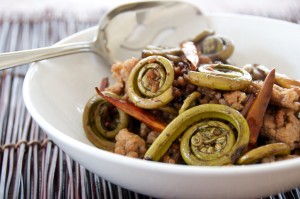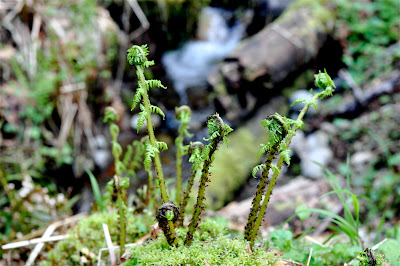 I’VE SHARED a number of Asian fiddlehead recipes over the years, two of my favorites being the above mentioned quick pickles and Sichuan dry-fried. The recipe here combines elements of both by stir-frying the pickled fiddleheads with a little ground pork, Sichuan peppercorns, and dried chile peppers.
I’VE SHARED a number of Asian fiddlehead recipes over the years, two of my favorites being the above mentioned quick pickles and Sichuan dry-fried. The recipe here combines elements of both by stir-frying the pickled fiddleheads with a little ground pork, Sichuan peppercorns, and dried chile peppers.
First, you’ll need to pickle some fiddleheads (a minimum half-pound) in the Sichuan style.
Sichuan Pickled Vegetables
1 quart-sized jar with lid
2 1/4 cup water
1/4 cup rock or sea salt
4 dried chiles
1/2 tsp whole Sichuan peppercorns
2 tsp rice wine
1/2 star anise
1 tbsp brown sugar
1-inch piece of unpeeled ginger
1/3 cinnamon stick
1 lb or more vegetables, such as string beans, slice carrot, daikon radish, etc.
1. Dissolve salt in boiling water and set aside to cool.
2. Add pickling spices to jar and add cooled water. Cover and shake to mix.
3. Fill jar with vegetables (e.g., fiddleheads), making sure brine covers them. Tighten lid and put aside in a cool, dark place for a minimum 24 hours; a week is better. You can continue to replenish the jar with vegetables by adding more salt, sugar, and wine.
Pickled Fiddleheads with Ground Pork
1/2 lb Sichuan pickled fiddleheads (see pickling recipe above)
1/4 lb ground pork
1/2 tsp rice wine
1/2 tsp soy sauce
1 tsp salt
2 tbsp peanut oil
3-4 dried chiles, halved and deseeded
1/2 tsp whole Sichuan peppercorns
1. Mix pork with rice wine, soy sauce, and salt in a small bowl.
2. Add 1 tbsp oil to wok over high heat until smoking. Add pork and stir-fry until dry and crumbly, a few minutes. Return meat to bowl.
3. Add 1 tbsp oil to wok over medium heat and quickly stir-fry Sichuan peppercorns and chiles until fragrant, careful not to burn, less than a minute. Add pickled fiddleheads and cooked pork into wok and continue stir-frying another couple minutes. Fiddleheads should remain tightly scrolled; serve before they start to unwind in the wok.
Serves 2 with another dish and rice, or 4 with a few additional dishes.
THE OTHER DAY I stir-fried some fresh fiddleheads in a very different Sichuan preparation, one relying on what is known as a fragrant fermented sauce (based on the mixture of sweet bean paste and soy sauce). This sauce is especially good with a simple stir-fry of beef or pork slivers with thinly sliced bell pepper, a popular dish all over Sichuan Province.
For my improvised version (see above), I stir-fried pressed seasoned tofu cut into cubes along with the fiddleheads, thin-sliced rounds of carrot, and flowering chives cut into 3-inch sections. It was delicious, but now I understand why the fragrant fermented sauce is most frequently encountered with slivers of meat and vegetables. Because of the large and varying shapes of my ingredients, rather than bathed in a comforting brown gravy, they were spotted with oily blots and most of the sauce drained to the bottom of the dish in a dark slick.
At least I have plenty of fiddleheads on hand to continue my experiments with this fleeting taste of spring.































